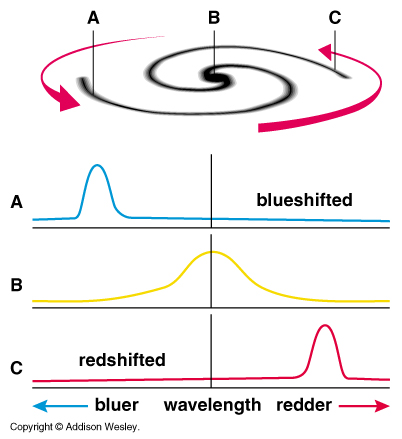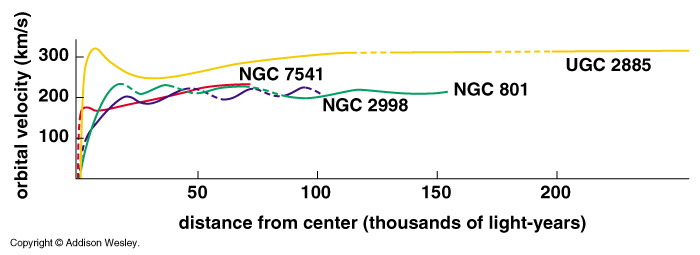
The rotation of our galaxy and many others have been measured using Doppler shifts of the 21cm (radio) line of hydrogen (from The Essential Cosmic Perspective, Bennett et al.)
Key points: Evidence for dark matter; ideas for what it is
 |
The rotation velocity of a galaxy can be measured from Doppler shifts
of its spectral lines. With the distance of the galaxy known, we can use Kepler/Newton
laws to compute the mass of the galaxy; in fact, we can map the mass as a function of the
distance from the center of the galaxy. The rotation of our galaxy and many others have been measured using Doppler shifts of the 21cm (radio) line of hydrogen (from The Essential Cosmic Perspective, Bennett et al.) |
| We find that galaxies do not rotate as if all their mass were in the
visible stars (as in the animation to the near right), but instead rotate at almost a
constant rate no matter the distance from their centers (as in the animation to the far
right). (from Clem Pryke, http://find.uchicago.edu/~pryke/dasi/documents/200309_plancourse/mgp00001.html)
|
 |
 |
 |
| If the mass followed the "normal" matter -- stars and gas -- the rotation speed would drop like the "Keplerian motion" line, like for the planets. Then their speeds would be as we derived when we were discussing Kepler's Laws. This relation assumes essentially all the mass is in the central object (the sun for the planetary system). | Instead, the rotation curve is nearly flat with increasing radius. Evidently there are huge amounts of unseen "dark" matter in the outer parts of the galaxy that add gravitational field beyond that just from the center, causing the stars and gas to orbit faster. (Figures from The Essential Cosmic Perspective, by Bennett et al.) |
To experiment with how this type of rotation curve comes about (and if your computer can do java), go to http://brahms.phy.vanderbilt.edu/~rknop/classes/a253/spiralrotator.html
 |
Like the Milky Way, virtually all galaxies have flat rotation curves to well beyond where they have many stars, indicating that they are all surrounded by large halos of dark matter. (From The Essential Cosmic Perspective, by Bennett et al.) |
When we account carefully for the mass in stars in a galaxy, it turns out to be much less than the mass we measure from Newton's laws! In addition, there appears to be mass we can't see outside the region occupied by the stars. As much of 90% of galaxies may be in some form of unseen mass.
We have no good idea of what galaxies are mostly made!! Could they have many brown
dwarfs? Or is there some basic particle of physics that we don't know about that accounts
for the unseen mass? This is evidently the dark matter we know played such a central role
in shaping the Universe, but all we know about local examples is from galaxy rotation
curves.![]() A good link for
further information is at http://www.eclipse.net/~cmmiller/DM/.
A good link for
further information is at http://www.eclipse.net/~cmmiller/DM/.
To make things even more mysterious, the distance measurements using Type 1 supernovae indicate that the expansion of the Universe is getting faster. We sort of explain this behavior as being due to "dark energy" that exerts a repulsive force and therefore makes the Universe tend to fly apart. It turns out that Einstein had included a term in his equations that can fit this behavior, although he thought it had been a mistake!
Test your understanding before going on![]()

John Flamsteed's constellation Andromeda, from Atlas Coelestis, http://www.bl.uk/whatson/exhibitions/mapmaker.html#ptolemy |

Pillars in M16, NASA, HST, J. Hester, P. Scowen, APOD http://antwrp.gsfc.nasa.gov/apod/ap951106.html |
|
Click to return to syllabus |
||
| Click to return to Discovery of Galaxies | hypertext |
Click to go to the Interstellar Medium |